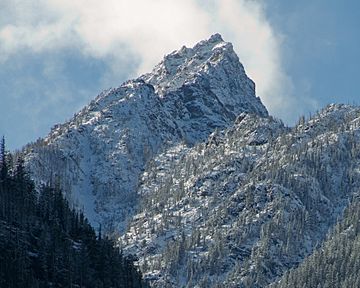Tupshin Peak facts for kids
Quick facts for kids Tupshin Peak |
|
|---|---|

Tupshin Peak from Lake Chelan
|
|
| Highest point | |
| Elevation | 8,320 ft (2,540 m) |
| Prominence | 1,080 ft (330 m) |
| Parent peak | Devore Peak 8360+ ft |
| Geography | |
| Parent range | North Cascades Cascade Range |
| Topo map | USGS Stehekin |
| Climbing | |
| First ascent | 1940 by Everett and Ida Darr |
| Easiest route | Climbing class 4-5 |
Tupshin Peak is a tall mountain, about 8,320 feet (2,536 meters) high. It's found in the beautiful Glacier Peak Wilderness area of the North Cascades in Washington state. This mountain is in Chelan County and is part of the Wenatchee National Forest.
Its closest taller neighbor is Devore Peak, which is about 1.5 miles (2.5 km) away to the south. Another peak, Bonanza Peak, is about 6.7 miles (10.8 km) to the southwest. Water from Tupshin Peak flows into nearby Lake Chelan through small streams that feed the Stehekin River. The name "Tupshin" comes from an old language called Chinook jargon, and it means "needle".
What's the Weather Like?
Most weather systems start over the Pacific Ocean. They usually travel northeast towards the Cascade Mountains. When these weather systems reach the North Cascades, the tall peaks force the air upwards. This process, called orographic lift, makes the air cool down and drop its moisture.
This is why the North Cascades get a lot of rain and snow. During winter, it's often cloudy and snowy. But in summer, high-pressure systems over the Pacific Ocean bring clear skies. This means there's usually little to no cloud cover during the warmer months.
How the Mountains Were Formed
The North Cascades have some of the most rugged and dramatic landscapes in the Cascade Range. You can see sharp peaks, tall spires, long ridges, and deep valleys carved by glaciers. Many millions of years ago, big geological events happened. These events created the varied landscape and huge changes in elevation across the Cascade Range. This also led to different climates in different areas.
The Cascade Mountains began forming millions of years ago, during the late Eocene Epoch. At that time, the North American Plate was slowly moving over the Pacific Plate. This movement caused many periods of volcanic activity. For example, Glacier Peak, a large stratovolcano, started forming about 21 miles (34 km) southwest of Tupshin Peak.
Also, small pieces of the Earth's crust, called terranes, helped create the North Cascades about 50 million years ago.
During the Pleistocene period, which started over two million years ago, glaciers moved across the land many times. As they advanced and retreated, they scraped away the landscape. They left behind piles of rock and debris. The "U"-shaped valleys you see today were formed by these glaciers. The combination of land being pushed up (called uplift) and cracks in the Earth's crust (called faulting), along with glaciation, created the tall peaks and deep valleys of the North Cascades.



